Heritage at Risk register: Hardingstone Eleanor Cross 'saved' but Weedon Barracks added


Nearly-finished repairs and conservation work, supported by a Historic England grant, on the 13th-century monument on London Road has meant it can be taken off the Heritage at Risk Register.
But the former army barracks in Weedon Bec, which date back to the Napoleonic wars, includes several at-risk buildings, according to Historic England.
Advertisement
Hide AdAdvertisement
Hide AdChief executive Duncan Wilson said: "The message is clear – our heritage needs to be saved and investing in heritage pays.
"It helps to transform the places where we live and work, and which we visit, creating successful and distinctive places for us and for future generations to enjoy. But there’s more work to do.
"There are buildings still on the Heritage at Risk Register that can be rescued and can be brought back to beneficial use and generate an income, contributing to the local community and economy. These are the homes, shops, offices and cultural places of the future.
"Historic England’s experience shows that with the right partners, imaginative thinking and robust business planning, we can be confident in finding creative solutions for these complex sites."
Advertisement
Hide AdAdvertisement
Hide AdThe Eleanor Cross is one of only three still standing of an original 12 which were constructed between 1291 and 1294 on the orders of King Edward I as a memorial to his dead wife, Queen Eleanor of Castile.
They were constructed at the sites where the Queen’s body lay overnight as her funeral procession journeyed from Harby in Nottinghamshire to London’s Westminster Abbey, such as Delapre Abbey.
Weedon Barracks' complex of military buildings were constructed as an ammunition store during the Napoleonic wars used by the British army until the 1960s.
In recent years a new private owner has carried out improvements and introduced new businesses to the site.
Advertisement
Hide AdAdvertisement
Hide AdThe east gate lodge was recently converted to a heritage centre telling the story of the site, with a grant from the National Lottery Heritage Fund.
Historic England has given a grant for a condition survey of the most vulnerable parts of the site and is discussing next steps with the owner.
Other at-risk locations in Northampton include listed buildings at 8, 8a, 9 and 9a George Row, the hillfort at Hunsbury Hill and the former St Crispin Hospital in Upton.
As well as the Old Church of St John the Baptist in Boughton, the Romano-British settlement and pottery kilns west of Ecton North Lodge and Roman villa north of Road Hill Farm near Harpole.
Advertisement
Hide AdAdvertisement
Hide AdIn total, 247 sites have been added in the past year, bringing the overall number of vulnerable sites to more than 5,000.
These include 1,492 listed buildings and structural scheduled monuments, 913 places of worship and more than 2,000 archaeological sites.
But 310 buildings and sites were removed from the register last year following repairs, stabilisation works or a new use.